Be Ready, Willing, and Able by Knowing How to Cook for LARGE Crowds
The World Central Kitchen (WCK). There’s an entity worth emulating! Since 2010, WCK, the global nonprofit founded by chef and humanitarian Jose Andres, has cooked hundreds of millions of fresh, nourishing meals for people impacted by natural disasters and other crises.
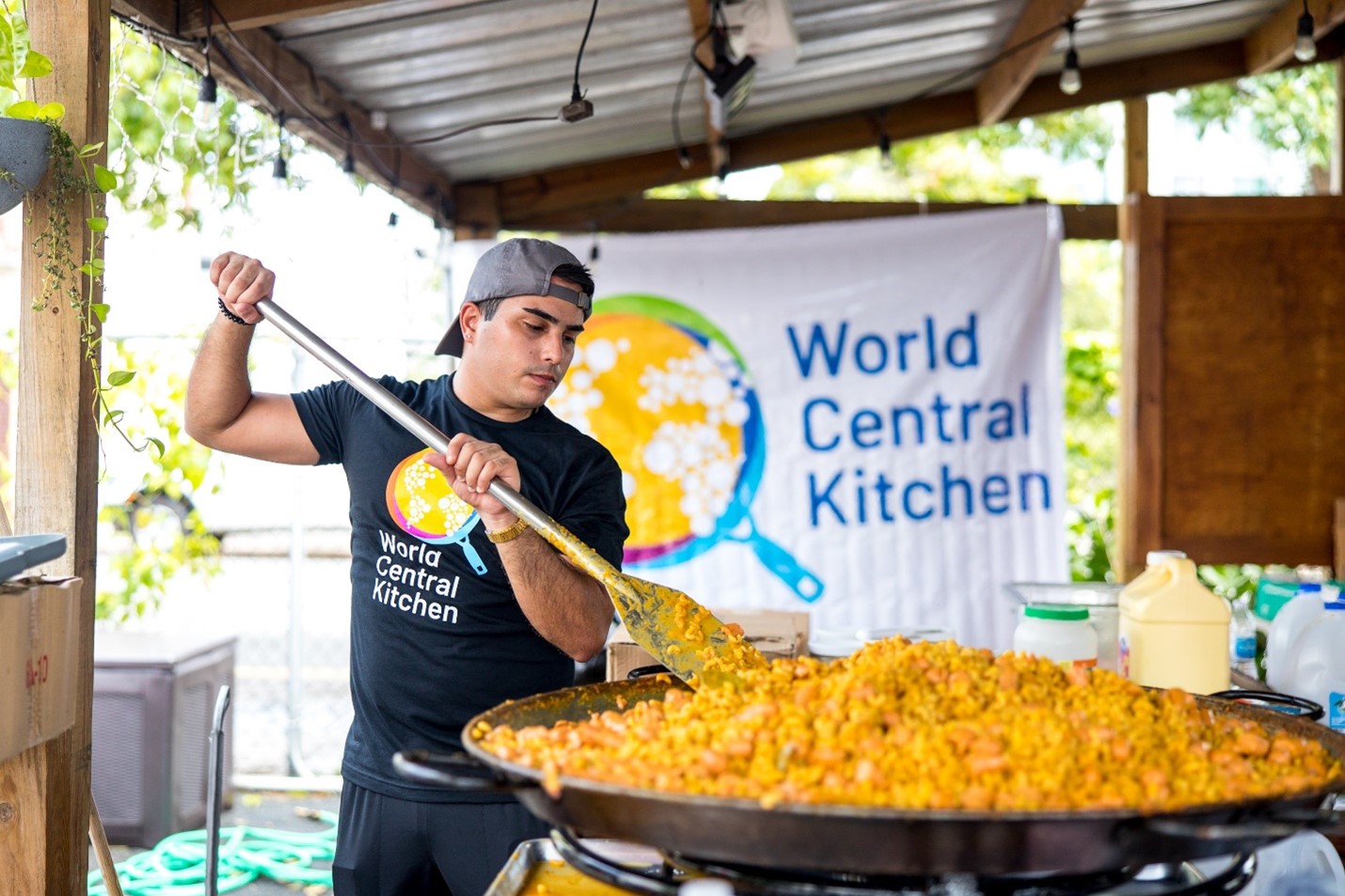
No matter the disaster, Chef Jose’s goal is always to provide not just food to the suffering, but dishes that nourish both body and soul during their difficult times. Chefs from around the world, community activists, and even a first lady and a duchess have provided recipes that celebrate the dignity, perseverance, and unending depth of the human spirit.
In 2023, Jose and fellow chef Sam Chapple-Sokol, published their cookbook, THE WORLD CENTRAL KITCHEN: Feeding Humanity, Feeding Hope. It’s filled with the recipes WCK uses over and over to feed humanity as they feed the world hope. You might want to check this book out.
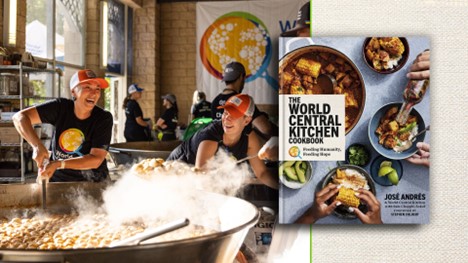
But apart from drawing attention to this marvelous organization and their phenomenal cookbook, the purpose of this article is to share some very important information that Jose and Sam offer in the introduction to their book. I say “important information” because it’s about how to upscale a recipe. Besides applying this skill to planning and cooking for family reunions and church or neighborhood dinners, we may one day need to cook for large groups experiencing a disaster in our own neck of the woods. You never know. If we’re prepared now, we can cope well later.
With your permission, I’d like to quote Jose and Sam. They explain that there’s both art and science to scaling recipes up from family-size dishes to large batches meant to feed the many. And they advise that you need to know your recipe inside and out, so be able to answer these questions before you get started:

• What are the ingredients and how do they each need to be prepped? • What are the most important flavors; how can I express them in the final bite? • How am I building flavor throughout the cooking process? • Textures: How should each individual component, as well as the final dish as a whole, feel?
“If you need to cook a recipe for a 1,000 people, cook it a few times at first, for four. What do you notice about the final version that you like, or did something not work out? Were there any inconsistencies in the four batches, and can you isolate what you did differently?
“Knowing the answers to these questions will help guide your process as you scale up.
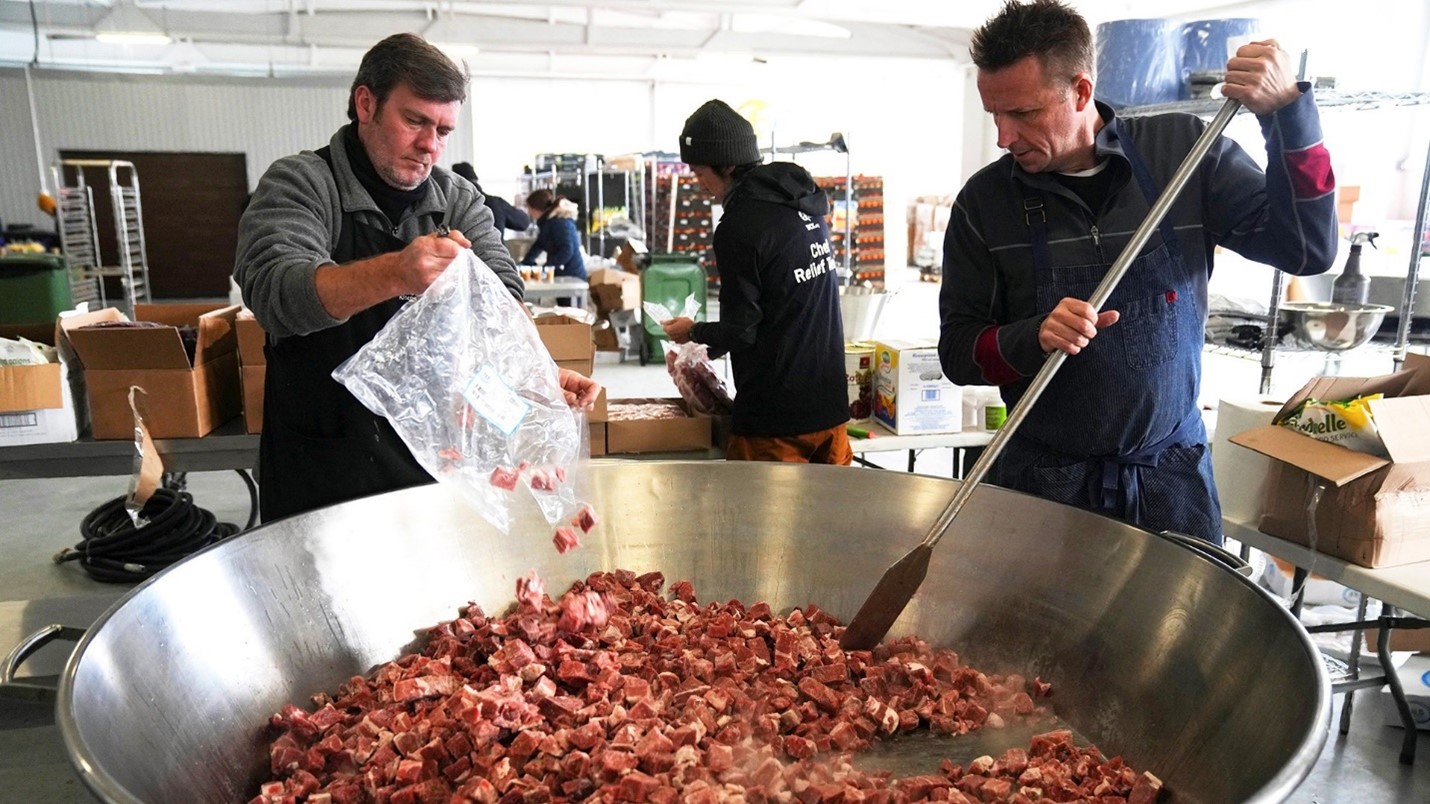
“Next, do the math. For instance: Understand that raw ingredients don’t weigh the same as their cooked counterparts due to water loss or gain. So, if we want everyone to receive 4 ounces of protein per meal and we’re cooking for 1,000 people, then we need to end up with 4,000 ounces (250 pounds) of cooked protein. But we need to figure out how much raw product that requires. Let’s say we’re cooking brisket: the USDA says cooked brisket weighs about 70% of what it weighed raw, so we’ll want to start with about 5,750 ounces (360 pounds) of raw brisket.”
And you can get the same mathematical guidance from the USDA for upscaling vegetables and grains, so I won’t take space here to explain that (go to https://foodbuyingguide.fns.usda.gov/Appendix/ResourceAppendixA and you’ll find their Recipe Analysis Workbook. It will walk you through all parts of a recipe). But Jose and Sam’s point is clear, right? We start with the math to get a clear roadmap for the next steps.
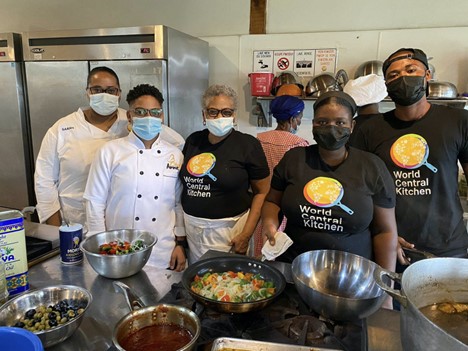
“Plan ahead. When you’re cooking for four, you may be able to prep as you go, but if you’re cooking for very large groups, you need to have your recipe pre-prepped. Bowls are your friends. If your onions and garlic cook together, chop them and put them in a bowl together. Use separate bowls for spices, vegetables, meats. That way, when you’re working through the recipe, you’ll be organized and ready for each step as it comes. And be sure to allow for plenty of time to cook—it takes longer to cook down more ingredients in a larger cooking vessel.”
And speaking of cooking vessels, Jose and Sam say to be sure to use the right equipment. They recommend paella pans because of their versatility and ease in transporting. Know that not just the circumference but also the depth of a pan can change serving numbers. A filled 15-inch pan serves 10 to 12; a 22-inch pan serves about 25 to 30; a 38-inch pan serves 200 to 250; a 52-inch pan will serve about 500.

“Know how to build flavor so the recipe shines at the end. Do proteins need to be marinated overnight instead of just a few hours? Do you need more spice paste or to deeply toast your spices? Do you need to dedicate extra time searing meat because the volume is so much greater? When cooking for hundreds or thousands at a time, it’s easy to lose flavor. Take the extra time to avoid this.”
Of course, they advise tasting the dish at every step of the process.
Jose and Sam’s upscaling tutorial concludes with the warning to “beware residual heat because in large batches, the internal residual heat of the dish is greater than when cooking a family-size amount. While this factor helps keep food hot in transport, it can also be destructive to the dish. Rice, vegetables, and pasta can quickly turn mushy; meats can go from tender to tough if you’re not careful.

“When it comes to pasta, we stop cooking before al dente, calculating that it’ll keep cooking to the right texture. If making a big batch and are worried about overcooking, choose pork shoulder over loin, chicken thighs over breasts, and beef roasts over steaks, for example.”
I’ll conclude Jose and Sam’s upscaling tutorial with my own advice: even if the odds are slim that you and I will ever need to cook for several hundred people, let’s do hang on to this information. Why not copy and paste it into your Cook’n 15 under the cookbook title “Cooking for LARGE Crowds.” REALLY LARGE crowds.
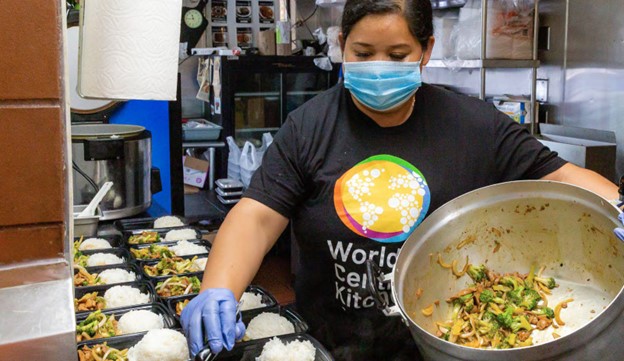
As I said in the beginning, the WCK is an entity worth emulating. They’re ready, willing, and able. We want to be the same!

No matter the disaster, Chef Jose’s goal is always to provide not just food to the suffering, but dishes that nourish both body and soul during their difficult times. Chefs from around the world, community activists, and even a first lady and a duchess have provided recipes that celebrate the dignity, perseverance, and unending depth of the human spirit.
In 2023, Jose and fellow chef Sam Chapple-Sokol, published their cookbook, THE WORLD CENTRAL KITCHEN: Feeding Humanity, Feeding Hope. It’s filled with the recipes WCK uses over and over to feed humanity as they feed the world hope. You might want to check this book out.

But apart from drawing attention to this marvelous organization and their phenomenal cookbook, the purpose of this article is to share some very important information that Jose and Sam offer in the introduction to their book. I say “important information” because it’s about how to upscale a recipe. Besides applying this skill to planning and cooking for family reunions and church or neighborhood dinners, we may one day need to cook for large groups experiencing a disaster in our own neck of the woods. You never know. If we’re prepared now, we can cope well later.
With your permission, I’d like to quote Jose and Sam. They explain that there’s both art and science to scaling recipes up from family-size dishes to large batches meant to feed the many. And they advise that you need to know your recipe inside and out, so be able to answer these questions before you get started:

• What are the ingredients and how do they each need to be prepped? • What are the most important flavors; how can I express them in the final bite? • How am I building flavor throughout the cooking process? • Textures: How should each individual component, as well as the final dish as a whole, feel?
“If you need to cook a recipe for a 1,000 people, cook it a few times at first, for four. What do you notice about the final version that you like, or did something not work out? Were there any inconsistencies in the four batches, and can you isolate what you did differently?
“Knowing the answers to these questions will help guide your process as you scale up.

“Next, do the math. For instance: Understand that raw ingredients don’t weigh the same as their cooked counterparts due to water loss or gain. So, if we want everyone to receive 4 ounces of protein per meal and we’re cooking for 1,000 people, then we need to end up with 4,000 ounces (250 pounds) of cooked protein. But we need to figure out how much raw product that requires. Let’s say we’re cooking brisket: the USDA says cooked brisket weighs about 70% of what it weighed raw, so we’ll want to start with about 5,750 ounces (360 pounds) of raw brisket.”
And you can get the same mathematical guidance from the USDA for upscaling vegetables and grains, so I won’t take space here to explain that (go to https://foodbuyingguide.fns.usda.gov/Appendix/ResourceAppendixA and you’ll find their Recipe Analysis Workbook. It will walk you through all parts of a recipe). But Jose and Sam’s point is clear, right? We start with the math to get a clear roadmap for the next steps.

“Plan ahead. When you’re cooking for four, you may be able to prep as you go, but if you’re cooking for very large groups, you need to have your recipe pre-prepped. Bowls are your friends. If your onions and garlic cook together, chop them and put them in a bowl together. Use separate bowls for spices, vegetables, meats. That way, when you’re working through the recipe, you’ll be organized and ready for each step as it comes. And be sure to allow for plenty of time to cook—it takes longer to cook down more ingredients in a larger cooking vessel.”
And speaking of cooking vessels, Jose and Sam say to be sure to use the right equipment. They recommend paella pans because of their versatility and ease in transporting. Know that not just the circumference but also the depth of a pan can change serving numbers. A filled 15-inch pan serves 10 to 12; a 22-inch pan serves about 25 to 30; a 38-inch pan serves 200 to 250; a 52-inch pan will serve about 500.

“Know how to build flavor so the recipe shines at the end. Do proteins need to be marinated overnight instead of just a few hours? Do you need more spice paste or to deeply toast your spices? Do you need to dedicate extra time searing meat because the volume is so much greater? When cooking for hundreds or thousands at a time, it’s easy to lose flavor. Take the extra time to avoid this.”
Of course, they advise tasting the dish at every step of the process.
Jose and Sam’s upscaling tutorial concludes with the warning to “beware residual heat because in large batches, the internal residual heat of the dish is greater than when cooking a family-size amount. While this factor helps keep food hot in transport, it can also be destructive to the dish. Rice, vegetables, and pasta can quickly turn mushy; meats can go from tender to tough if you’re not careful.

“When it comes to pasta, we stop cooking before al dente, calculating that it’ll keep cooking to the right texture. If making a big batch and are worried about overcooking, choose pork shoulder over loin, chicken thighs over breasts, and beef roasts over steaks, for example.”
I’ll conclude Jose and Sam’s upscaling tutorial with my own advice: even if the odds are slim that you and I will ever need to cook for several hundred people, let’s do hang on to this information. Why not copy and paste it into your Cook’n 15 under the cookbook title “Cooking for LARGE Crowds.” REALLY LARGE crowds.

As I said in the beginning, the WCK is an entity worth emulating. They’re ready, willing, and able. We want to be the same!
 Alice Osborne
Alice Osborne
Weekly Newsletter Contributor since 2006
Email the author! alice@dvo.com
